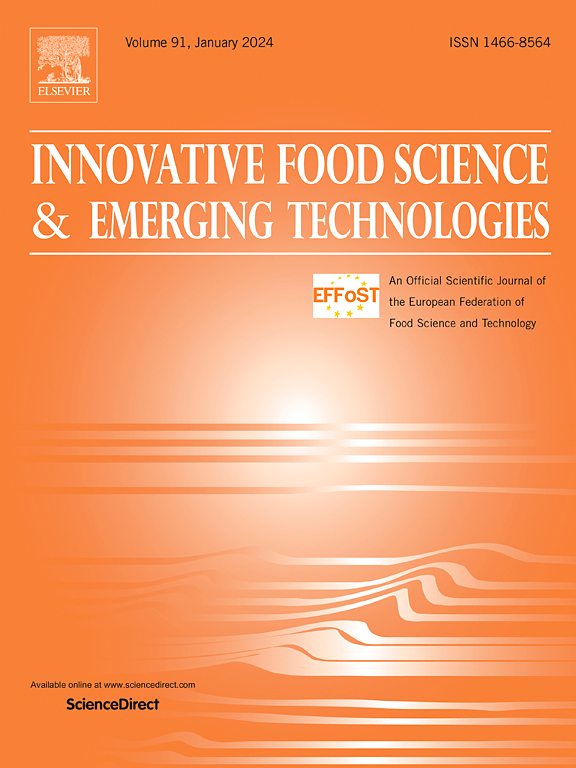The role of green technologies in producing wheat gluten nanofibers by electrospinning and improving their water resistance
IF 6.3
1区 农林科学
Q1 FOOD SCIENCE & TECHNOLOGY
Innovative Food Science & Emerging Technologies
Pub Date : 2025-03-09
DOI:10.1016/j.ifset.2025.103994
引用次数: 0
Abstract
Electrospinning of irregular proteins is possible if they can be dissolved appropriately and their spherical structure can be changed to a random coil, which is generally not the case for plant proteins. Thus, the effect of each solvent, including acetic acid (AA), ethanol (ET), and water (WA) alone, as well as their binary mixtures at 70:30, 50:50, and 30:70 (v/v) ratios on the nanofibers (NFs) obtained from treated gluten was investigated. Where the binary solvent systems of AA: ET and ET: WA (70:30 ratios) were selected, the average NFs diameters were 482.22 and 312.74 nm, respectively. Next, the effects of 3 factors, including solvent type, high hydrostatic pressure/HHP (0, 400, and 600 MPa), and dithiothreitol (DTT) (0 and 1 % of the protein weight) on gluten NFs were studied. Applying HHP and DTT effectively altered the protein conformation from β-sheets to random coils. Considering fiber morphology (no beads and uniformity of fiber morphology) and production conditions, the sample treated at 400 MPa containing DTT was selected for gluten electrospinning in the AA: ET (70:30 v/v) solvent system. Finally, the effects of sandwiching (layers of zein protein), thermal, cross-linking with oxidized sucrose, and plasma methods on increasing the hydrophobicity of fibers were investigated. The dissolution time of different treatments, including sandwich NFs, thermal, and plasma methods, was 11.77, 35, and 1.19–4.64 s, respectively; the thermal method was proposed as the best modification method.

绿色技术在静电纺丝生产小麦面筋纳米纤维及提高其耐水性中的作用
不规则蛋白质的静电纺丝是可能的,如果它们可以适当地溶解,并且它们的球形结构可以改变为随机线圈,这通常不是植物蛋白质的情况。因此,研究了每种溶剂,包括单独的乙酸(AA)、乙醇(ET)和水(WA),以及它们以70:30、50:50和30:70 (v/v)比的二元混合物对从处理过的面筋中获得的纳米纤维(NFs)的影响。当选择AA: ET和ET: WA(70:30)二元溶剂体系时,纳米颗粒的平均直径分别为482.22 nm和312.74 nm。然后,研究了溶剂类型、高静水压力/HHP(0、400和600 MPa)和二硫苏糖醇(DTT)(蛋白质质量的0和1%)3个因素对谷蛋白NFs的影响。应用HHP和DTT有效地改变了蛋白质的构象,从β-片到随机线圈。考虑到纤维形态(无珠和纤维形态均匀性)和生产条件,选择含DTT的400 MPa处理样品在AA: ET (70:30 v/v)溶剂体系中进行面筋静电纺丝。最后,研究了玉米蛋白夹层法、热交联法、氧化蔗糖交联法和等离子体法对提高纤维疏水性的影响。夹层法、热法和等离子体法的溶出时间分别为11.77、35和1.19 ~ 4.64 s;热法是最佳的改性方法。
本文章由计算机程序翻译,如有差异,请以英文原文为准。
求助全文
约1分钟内获得全文
求助全文
来源期刊
CiteScore
12.00
自引率
6.10%
发文量
259
审稿时长
25 days
期刊介绍:
Innovative Food Science and Emerging Technologies (IFSET) aims to provide the highest quality original contributions and few, mainly upon invitation, reviews on and highly innovative developments in food science and emerging food process technologies. The significance of the results either for the science community or for industrial R&D groups must be specified. Papers submitted must be of highest scientific quality and only those advancing current scientific knowledge and understanding or with technical relevance will be considered.

 求助内容:
求助内容: 应助结果提醒方式:
应助结果提醒方式:


